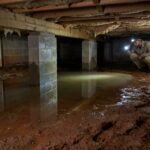Essential Guide to Foundation Repair: How to Protect Your Home from Structural Damage
When it comes to the stability of your home, the foundation is like a good friend who carries your secrets and stands strong when times get tough. But what happens when that sturdy friend starts showing signs of wear and tear? Cracks in the walls, doors that refuse to close, and windows that seem to have taken up yoga—these are just a few signs that your foundation might be in trouble. Fear not! This essential guide to foundation repair will help you understand why foundations fail, how to spot problems early, and what steps you can take to protect your beloved abode from structural damage.
Understanding Foundations and Their Importance
Before we dive into the nitty-gritty of repairs, it’s essential to understand what a foundation does. Think of your home’s foundation as its superhero cape—it keeps everything together while fighting off the forces of Mother Nature. A proper foundation supports the weight of your house, prevents moisture intrusion, and protects against soil movement. When it falters, your entire structure is at risk.
There are several types of foundations, including:
1. **Basements**: These are common in colder climates where frost protection is necessary. Basements provide extra living space and storage but can be susceptible to water damage if not properly sealed.
2. **Crawlspaces**: These elevate the home above ground level, allowing ventilation and access to plumbing. However, they can become moldy and inviting for pests if not maintained.
3. **Slab foundations**: Popular in warmer areas, slab foundations sit directly on the ground. While they’re less prone to some issues, drainage problems can lead to cracking.
The importance of a solid foundation cannot be overstated. It influences the longevity and safety of your home. So, let’s explore the most common foundation issues!
Signs Your Foundation Might Need Help
Recognizing issues early can save you a lot of headaches down the road—and avoid that dreadful scene when your living room becomes a swimming pool (unless that’s your style, of course). Here are some signs to watch out for:
1. **Cracks in Walls**: If you notice cracks forming in your drywall or plaster, particularly around door frames or windows, it’s time to pay attention. Small hairline cracks can be common, but large cracks may indicate serious distress.
2. **Uneven Floors**: If you feel like you’re walking on a funhouse floor instead of solid ground, your foundation may be sinking or shifting.
3. **Doors and Windows That Stick**: If your doors and windows are starting to act like they’re auditioning for a horror movie—creaking, sticking, or not closing properly—it could be due to foundation movement.
4. **Gaps Between Trim and Walls**: Gaps where your baseboards meet the wall or window trim are often signs of settling.
5. **Water Accumulation**: Standing water in your yard, especially near the foundation, can spell trouble. It’s like your property is trying to turn into a mini golf course—but it might lead to serious damage instead.
6. **Moisture Issues**: Excessive humidity, dampness, or mold in your home can often be traced back to foundation problems.
If you’ve spotted any of these signs, don’t panic! There are ways to assess and address the situation.
Assessing the Foundation Issue
First things first: determining whether your problems are really foundation-related or just a cosmetic issue. Here are a few steps to help you figure it out:
1. **Visual Inspection**: Walk around your home and inspect both the interior and exterior. Look for any signs of cracking in the brick, mortar, or concrete. Pay special attention to corners, as they are often the first places to show distress.
2. **Check for Slopes**: Take a marble (yes, the classic childhood toy) and place it on various surfaces of your floors. If it rolls uncontrollably in a specific direction, your foundation may be sloping.
3. **Water Drainage**: Observe how water drains around your home. If you notice puddles near the foundation after heavy rain, this could lead to problems down the line. Make sure your gutters are clean and directing water away from the house.
4. **Consult the Experts**: If you’re still unsure or uncomfortable with your findings, don’t hesitate to reach out to a foundation repair specialist. They have the expertise and tools to perform a thorough assessment and recommend necessary actions.
Types of Foundation Repairs
If your foundation needs some TLC, there are several methods available to address the problem. Different issues require different fixes, so here’s a rundown of the most common repair types:
1. **Crack Repair**: Minor cracks can often be repaired with epoxy injections or polyurethane foam. This involves injecting the material into the crack to seal it up and prevent further water intrusion.
2. **Piering Systems**: For significant settling issues, piering may be the solution. This method involves pushing steel piers deep into the ground until solid bedrock or soil is reached, stabilizing the foundation and lifting it back to its original position.
3. **Slabjacking**: This technique is used to lift a sunken concrete slab by injecting a mixture of materials under the slab. Think of it as a gentle nudge to get things back in place.
4. **Wall Anchors**: If you have bowing basement walls, wall anchors can help stabilize them. This method uses cables and earth anchors to pull the wall back into a more vertical position.
5. **Drainage Solutions**: Often, foundation issues stem from poor drainage. Installing French drains, sump pumps, or other drainage systems can help divert water away from the foundation, preventing future issues.
Preventive Measures to Protect Your Foundation
As the saying goes, “An ounce of prevention is worth a pound of cure.” Here are some proactive steps you can take to keep your foundation happy and healthy:
1. **Maintain Your Gutters**: Keep gutters clear and ensure downspouts direct water at least six feet away from the foundation. This will help prevent erosion and moisture accumulation.
2. **Manage Landscaping**: Ensure that soil slopes away from your foundation. Additionally, avoid planting large trees too close to your home – their roots can wreak havoc on your underground infrastructure.
3. **Control Irrigation**: Be mindful of watering your lawn. Consistent saturation can lead to soil expansion and contraction, which may shift your foundation.
4. **Monitor Moisture Levels**: Consider using a dehumidifier in areas prone to moisture or installing vapor barriers in crawlspaces.
5. **Regular Inspections**: Schedule annual foundation inspections, especially if you live in an area with extreme weather conditions or high clay content in the soil.
When to Call a Professional
While you might fancy yourself a home repair aficionado, some situations require professional help. If you notice significant cracks, persistent moisture issues, or noticeable changes in your home’s structure, it’s best to consult a foundation repair expert. They can provide you with a comprehensive evaluation and recommend the best course of action.
Choosing the Right Foundation Repair Company
If your foundation requires professional attention, selecting the right company is crucial. Here are some tips to ensure you make a wise choice:
1. **Research and Reviews**: Look for companies with a solid reputation. Check online reviews and ask for references from previous clients.
2. **Experience and Credentials**: Verify the company’s experience in foundation repair and check if they have the appropriate licenses and insurance.
3. **Detailed Estimates**: A reliable contractor should provide a detailed estimate outlining the work involved and the costs associated.
4. **Warranty**: Ask about warranties for the work performed. A reputable company should stand behind their repairs.
5. **Communication**: Choose a company that communicates clearly and is willing to address your questions and concerns.
Conclusion
Foundation repair may not be the most glamorous topic—after all, it’s not exactly a trending home decor subject—but understanding and addressing foundation issues is vital for protecting your home from structural damage. By recognizing the signs of trouble, assessing the situation, and taking preventive measures, you can keep your home’s foundation as solid as ever.
Remember, a well-maintained foundation means fewer issues down the road and a safer, more secure home. And who knows? You might even find joy in knowing that you’ve kept your home standing strong against the test of time. So, give your foundation a little love—it deserves it!


